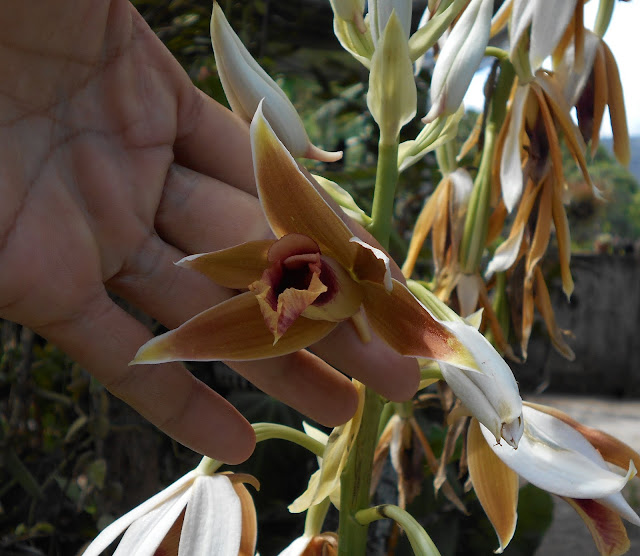What is the real identity of Phaius antoninae?
In 2011, Peter Balzer described a new Phaius species as P. antoninae, in honor of his wife Antonina. The new species was compared to P. tankervilleae, and differing from it mainly by way of the sepals and petals being longer than the labellum. In 2017, Judi V. Stone and Phillip J. Cribb absorbed it as a variety of P. tankervilleae, as P. tankervilleae var. antoninae, a decision that stands to this day. I have been keeping this species/variety for quite some years already and find it to be a very accommodating and fast-growing plant. Upon maturity of the leaves, tall inflorescences appear as sure as the sun is going to rise tomorrow.
As problem-free as these plants are, I have one hang-up: the flowers stay limp instead of opening and advertising themselves up proudly, which is a shame because these are by no means small flowers. If only those blooms will shave away some of their shyness then what a show they would make. Additionally, those blossoms emit a scent similar to Phalaenopsis schilleriana, albeit weaker. But there is no denying it: P. antoninae, or P. tankervilleae var. antoninae, if that is what you want to call it, is an apomictic species. Apomixis- or the setting of seeds without the benefit of fertilization resulting in seedlings identical to the parent plants- is frequently observed in many terrestrial orchids, particularly in the mycoheterotrophs (parasitic on fungi). Such plants have bypassed the pollination syndrome and have found a way to perpetuate themselves without the help of pollinators. The ghostly Epipogium roseum is a fine example of an apomictic species. At this juncture, one might think that P. tankervilleae var. antoninae is an apomictic variety of the species. Or is it?
 |
Above and below: two flowers 'forced' to smile for the camera. Note the labellum that does not open widely. |
Maybe, but I believe things are much simpler than that. Back in the early 2000s when these plants were not yet described as new, I found populations in the province of Quezon all displaying those large, nodding flowers. That means that they do form a population separate from typical P. tankervilleae. In taxonomy, any plant that is morphologically similar to an earlier described species but displaying minor differences AND forming populations of its own merits a varietal status. I find no morphological distinction of antoninae except that the sepals and petals are indeed somewhat longer in comparison to the length of the labellum, so yeah, maybe it indeed is a variety of tankervilleae. However, in my many forays into the great outdoors I have also found populations of Spathoglottis plicata with flowers smaller than the usual, with 'cuppy' segments and rachis heavily laden with developing pods. Flowers of such plicatas open up, but not too widely, and then droop the next day. Upon closer inspection, one can see that all prior flowers have their ovaries thickened in various stages of development- an apomictic population. Normal plicatas have flowers that remain open far longer than that and fewer actually get pollinated. And yet, no one has yet described these self-fertile populations as plants worthy of taxonomic recognition, and for good reason: these plants are still S. plicata by any stretch of the imagination. But going back to antoninae, another way of interpreting the length of the floral segments as compared to P. tankervilleae is that the sepals and petals are actually of typical dimensions- it's the labellum that has become shorter because these plants don't need the organ to lure potential pollinators because, uhm, they are fully capable of making love to themselves. 'Go f**k yourself' has acquired a new meaning in the world of botany. Epipogium roseum, I hope you are reading this. And if so, subscribe to the blog so you will be alerted the next time I talk about you.
Are plants of P. tankervilleae var. antoninae worthy of any taxonomic ranking? You tell me. But as far as I am concerned, these are no more than self-fertile examples of P. tankervilleae and nothing more.
Now I'm just waiting for someone to either place P. antoninae under the synonymy of P. tankervilleae, or name those aberrant plicatas as 'new'. Authorship hogs, here's your cue.
 |
| An apomictic plant of Spathoglottis plicata. |






Comments
Post a Comment